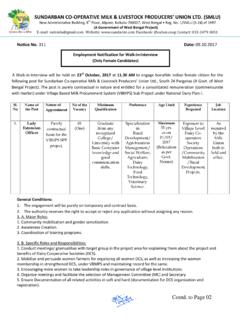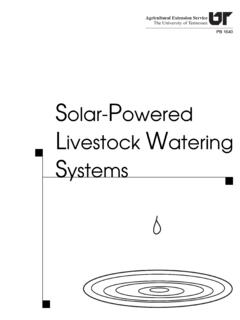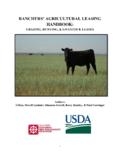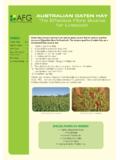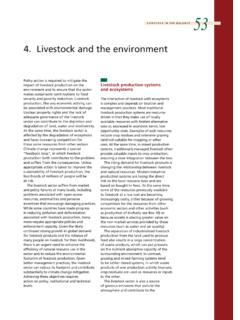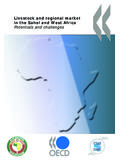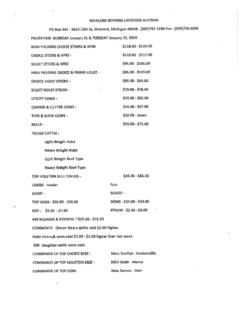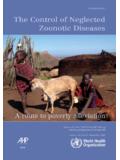Transcription of Livestock Policies, Land and Rural Conflicts in Sub ...
1 Pro-Poor Livestock Policy Initiative A Living from Livestock Research Report 1 RR Nr. 07-04, Feb. 2007 Livestock policies , land and Rural Conflicts in Sub-Saharan Africa Ugo Pica-Ciamarra, Joachim Otte, Pius Chilonda Abstract The paper proposes a pro-poor policy framework to systematically assess Livestock sector policies in Ethiopia, Kenya, Uganda and Tanzania in East Africa, and in Burkina Faso, Mali and Senegal in West Africa. Livestock policies in the countries reviewed do not consistently address the land tenure issue for farmers and pastoralists and, in response to tenure insecurity, Livestock keepers may possibly increase animal stock beyond land carrying capacity, thus contributing to enhanced competition for scarce resources and, eventually, to violent Conflicts .
2 Tenure insecurity is therefore identified as an endogenous determinant of Rural Conflicts . 1. IntroductionIncreasing population, income growth and urbanization are driving up the demand for food of animal origin in developing countries. In sub-Saharan Africa meat and milk demand are expected to grow by and per annum between 1997 and 2020 (Rosegrant et al., 2001). This structural shift in food consumption could contribute to economic development and poverty reduction: not only several African countries boast comparative advantages in the production of animal protein, but an estimated 60% of the poor in Africa are dependent on Livestock as part of their livelihoods (Thornton et al.)
3 , 2002). African countries, however, are not taking full advantage of the poverty reduction opportunities of the increased demand for food of animal origin: Livestock production is not keeping the pace with demand trends, and a number of countries have become net importers of meat and, particularly, dairy products. PPLPI Research Report 2 This paper proposes a framework for examining gaps and bottlenecks in the current Livestock policy agenda, and reviews Livestock policies in Ethiopia, Kenya, Uganda and Tanzania in East Africa, and in Burkina Faso, Mali and Senegal in West Africa. It argues that land tenure issues are largely neglected by African policy makers. The ensuing question this paper attempts to address is whether ineffective land policies , and the associated land tenure insecurity, not only make it difficult for Livestock keepers to take advantage of the growing demand for animal food, but can also be considered as an endogenous determinant of Rural Conflicts .
4 Section two briefly introduces the Livestock sector in the case study countries, elaborates a pro-poor Livestock policy framework and assesses the current Livestock policy agenda in East and West Africa. It is found that current policies do not consistently address the land tenure issue for farmers and pastoralists. Whether this is good or bad depends on the weaknesses and strengths of the current land tenure system. Section three, therefore, reviews the evolution of land policies in sub-Saharan Africa since independence, and concludes that existing laws and regulations do not provide Rural dwellers with adequate land tenure security. Section four argues that inadequate and insecure access to land not only contributes to inefficient resource allocation, but might provide farmers and pastoralists with incentives to increase Livestock numbers beyond the land carrying capacity, thus enhancing competition for scarce resources and contributing to violent Conflicts in Rural areas.
5 The last section summarizes the main findings and identifies avenues for further research. 2. Unbalanced Livestock policies in Sub-Saharan Africa Ethiopia, Kenya, Uganda and Tanzania in East Africa, and Burkina Faso, Mali and Senegal in West Africa are low income economies. GDP per capita averages between US$ 622 (Ethiopia) and US$ 1,463 (Senegal), and about 40% of the population live below the international poverty line. These economies are largely agricultural, the primary sector contributing between (Kenya) and (Ethiopia) to national value added and over 60% to employment (World Bank, 2005). Growth of agriculture, therefore, could significantly support poverty reduction and economic development.
6 The development of the Livestock sector might, in turn, contribute to agricultural growth and poverty alleviation. (i) The case study countries have a comparative advantage in Livestock production, with pasture land constituting over 70% of the agricultural area, and Livestock accounting for 30% to 52% of agricultural value added and up to of GDP (FAOSTAT, 2005). (ii) Preliminary estimates suggest that most of the Rural poor hold Livestock , from a low of 53% in Kenya to a high of 69% in Uganda (Thornton et al., 2002). Investing in the sub-sectors where the poor mostly work naturally has a stronger impact on poverty than growth in other PPLPI Research Report 3 sectors.
7 (iii) Increasing GDP per capita, urbanization and population growth are boosting the demand for animal protein in sub-Saharan Africa: total consumption of meat and milk grew annually by and percent in 1974-1997, and is expected to grow by and percent per year in 1997-2020 (FAOSTAT, 2005; Rosegrant et al., 2001). Table 1: Livestock and poverty in sub-Saharan Africa, 2003. StockPovertyEthiopia22,316549,1751,518, , ,548455,7322,853, , ,919360,540935, , ,528292,751700, , Faso4,622141,019237, , ,527259,052578, , ,250161,993124, , addedMeat (Mt)Milk (Mt)% of GDP% of agricultural value added*TLU: Tropical Livestock Unit; conversion factors: cattle ( ), sheep and goats ( ), pigs ( ) and poultry ( )% of Rural poor holding livestockMeat (Mt)Milk equivalent (Mt)CountryNet tradeTLUs* (000) Source: Elaborated from FAOSTAT (2005) and Thornton et al.
8 (2002). African policy makers, however, have not taken full advantage of the poverty-reduction potentials of Livestock sector. In the sample countries, in fact, meat and milk production have been unable to keep pace with the growing demand for animal food and, in some circumstances, per-capita consumption decreased. Imports of meat and, particularly, milk have increased significantly (FAOSTAT, 2005). African decision makers, therefore, should re-design Livestock policies so as to direct the development of the sector towards a pro-poor path, and derive benefits from the increased demand for animal food. In the socio-economic literature, however, while macroeconomic and agricultural sector policies have been categorized under several aspects, there is a paucity of Livestock sub-sector policy analyses: Livestock policies are either completely overlooked or considered as a mixture of macroeconomic and agricultural sector public actions, with a few ad-hoc technical interventions in the Livestock sector ( animal vaccination).
9 But Livestock development requires not only sound macroeconomic, institutional and agricultural sector policies , but also public policies that respond to the peculiarities of Livestock production, which is associated with specific market imperfections and public goods. Following Dorward et al. (2004) it is argued that, given a favourable macroeconomic and institutional environment, governments should design and implement Livestock policies targeted at achieving three major objectives for the poor Livestock holders, including: (i) protecting assets / reducing vulnerability ; (ii) creating conditions for growth ; (iii) sustaining growth . PPLPI Research Report 4 (1) policies Protecting assets / reducing vulnerability aims at providing the poor Livestock holders with adequate and secure access to basic production inputs.
10 This objective contains two subsidiary policy objectives, which are: (a) securing access to land , water and feed, and (b) providing risk coping mechanisms for natural disasters and price shocks. Uncertainty and market imperfections, in fact, prevent smallholder producers from having secure access to these inputs, which is a necessary condition for efficient resource allocation. For example, in mixed crop- Livestock farming systems secure access to land allows farmers to use resources (such as family labour) that in many cases are underused and encourages lump-sum investments in physical and human capital, with increasing supply of crop residues and stubbles for animals. In pastoral areas, secure rights to use different patches of land allow Livestock keepers to access fodder and water continuously and reduce risks associated with droughts; at the same time, high variability of returns may induce pastoralists to over-stock and use Livestock as a form of insurance rather than as a means of production.










